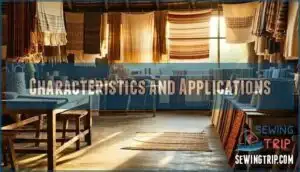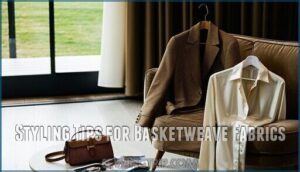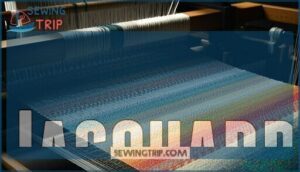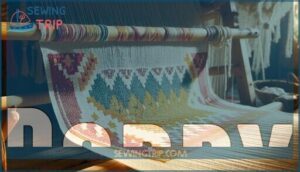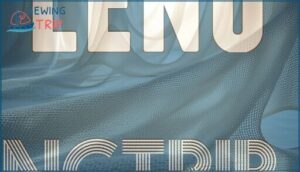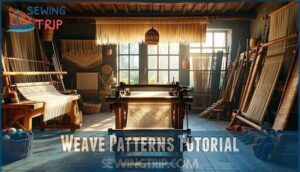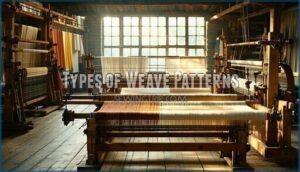This site is supported by our readers. We may earn a commission, at no cost to you, if you purchase through links.
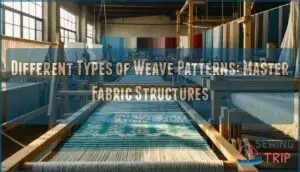
Basketweave creates sturdy, textured surfaces by doubling threads. Jacquard looms control individual yarns to produce intricate damasks and brocades. Dobby mechanisms lift specific shafts for geometric patterns, while leno twists warp threads around each other for breathable, open structures.
Understanding these constructions lets you decode why certain fabrics drape, breathe, or resist wrinkles the way they do, transforming you from passive consumer to informed decision-maker who recognizes quality and selects textiles that match your exact needs.
Table Of Contents
Key Takeaways
- The foundational weave patterns—plain, twill, and satin—each shape fabric’s strength, drape, and look, forming the backbone of textiles from cotton shirts to upholstery.
- Advanced techniques like Jacquard, Dobby, Basketweave, and Leno add diversity, letting you create everything from bold patterns and textured surfaces to breathable gauze.
- Understanding how threads interlace—at right angles, in pairs, diagonally, or twisted—lets you read and select fabrics with purpose, choosing what fits best for comfort, durability, or style.
- Weaving innovations, from early looms to today’s automated designs, enable endless creative freedom and influence both textile technology and everyday fabric choices.
Basketweave
Basketweave is a variation of plain weave that doubles up threads to create a distinctive checkerboard texture. You’ll recognize it by the way warp and weft yarns alternate in pairs, mimicking the look of woven baskets.
Here’s what makes basketweave fabrics work for you and how to style them with confidence.
Characteristics and Applications
If you’re exploring the domain of weave patterns, the basketweave stands out with its distinctive characteristics and adaptable applications. Picture threads grouped in pairs, interlacing to create a checkerboard effect that’s both striking and sturdy. This structure amplifies fabric strength and weave density while maintaining breathability—making it a go-to for everything from upholstery to towels.
Your yarn selection matters here—thicker threads augment that coveted basket effect.
- Fabric durability: The doubled-thread construction resists wear and tear better than plain weave.
- Fabric texture: Creates a pronounced surface perfect for visual interest in home textiles.
- Drape analysis: Generally stiffer than twill, ideal when fabric properties need structure over fluidity.
Styling Tips for Basketweave Fabrics
Once you grasp basketweave’s structural strengths, you can release its full potential by experimenting with texture and silhouette in your wardrobe. Pair basket weave jackets with smooth silks for textural contrast that grabs focus.
Try seasonal styling—lighter weaves for summer blazers, heavier ones for winter coats. Mix fabric patterns boldly: basketweave pairs beautifully with stripes or solids.
For accessorizing tips, consider structured bags that echo the weave’s geometry, amplifying fabric properties through thoughtful color combinations.
Jacquard
Jacquard weaving breaks the rules of basic fabric construction, letting you create intricate patterns that were once impossible by hand. This technique uses specialized looms to control individual warp threads, opening up endless design possibilities.
Let’s explore how Jacquard transforms yarn into art and where you’ll find these stunning fabrics in everyday life.
Complex Patterns and Jacquard Looms
Jacquard looms transformed textile technology when Joseph-Marie Jacquard patented his innovation in 1804, slashing production time by 80%. Today, digital weaving powered by CAD software lets you create complex weave patterns with precision that wasn’t possible before.
Modern Jacquard design controls every single warp thread individually, weaving up to 10,000 unique movements per square meter. This fabric innovation extends beyond traditional textiles—smart materials now embed conductive threads for health monitoring.
The twill weave and dobby weave pale beside Jacquard’s complexity, positioning the Jacquard loom as your gateway to unlimited creative freedom in textile technology. The historical significance of the Jacquard mechanism is evident in its influence on computing history and its lasting impact on the industry.
Versatile Uses in Clothing and Home Decor
From couture runways to your living room, Jacquard weaving brings the same intricate artistry whether you’re slipping into a textured blazer or sinking into a damask-upholstered sofa. This fabric design revolution lets you break free from flat, predictable surfaces.
Modern textile innovation merges Jacquard weave complexity with sustainable materials, creating clothing trends that don’t compromise the planet. You’ll spot these fabric patterns and designs everywhere—from high-fashion gowns with metallic threads to statement throw pillows that anchor your space. Textile manufacturing and production now rivals even satin weave’s luxury and twill weave’s durability.
- Evening wear: Brocade cocktail dresses with raised floral motifs
- Upholstery: Damask sofas featuring medallion patterns
- Outerwear: Structured blazers with geometric Jacquard details
- Window treatments: Jacquard curtains with custom-woven borders
- Accessories: Woven clutches showcasing intricate textile artistry
Dobby
Dobby weave breaks free from the limitations of basic patterns, giving you geometric designs and textured effects that plain weaves can’t touch. This technique uses a specialized loom attachment to control individual warp threads, creating small repeating motifs across your fabric.
Let’s explore what makes dobby weave distinct and which fabrics utilize its creative potential.
Distinguishing Features of Dobby Weave
If you’ve ever run your hand across a shirt with subtle geometric patterns woven right into the fabric, you’ve likely encountered the dobby weave—a technique that punches far above its weight in creating texture without the complexity of jacquard machinery.
Dobby looms control individual warp threads through shaft mechanisms, letting you create small-scale patterns with precision. The fabric weave structure produces raised textures and geometric motifs at higher weave density than plain weaves, while thread count remains manageable for production efficiency.
| Feature | Dobby Weave | Plain Weave |
|---|---|---|
| Pattern Complexity | Small geometric designs | Simple over-under |
| Fabric Texture | Raised, dimensional | Flat, smooth |
| Weaving Techniques | Shaft-controlled threads | Basic interlacing |
These weaving techniques release creative potential—from shirting to upholstery—without jacquard’s elaborate setup.
Popular Fabrics Utilizing Dobby Weave
You’ll spot dobby weave’s signature texture in Cotton Fabrics for dress shirts—65% of men’s formal shirting relies on dobby techniques. Silk Textiles shine in luxury blouses and scarves, capturing 8–12% of high-end formalwear. Polyester Blends dominate workwear and uniforms, accounting for 56% of synthetic work clothing across Asia. Linen Materials enhance summer collections, comprising 22% of premium warm-weather apparel.
The dobby loom’s shaft-controlled precision unlocks these fabric manufacturing processes, weaving patterns and techniques that create raised geometric motifs across diverse types of fabric weaves—from piqué polo shirts to decorative home textiles. The unique characteristics of dobby weaves are made possible by the special loom attachment that allows for the creation of complex designs.
Leno
Leno weave breaks the rules by twisting warp yarns around each other, creating an open, gauze-like structure that’s surprisingly strong.
This unconventional technique creates opportunities for fabrics that breathe, filter, and flex in ways traditional weaves can’t match.
Let’s explore how leno’s twisted architecture works and where it makes the biggest impact.
Twisting Warp Yarns in Leno Weave
Think of Leno weave as the rebel of textile construction—where most fabrics keep their warp yarns parallel and obedient, Leno breaks the rules by twisting them around each other like a secret handshake. This warp yarn twisting creates an open, stable structure you won’t find in twill weave or plain patterns.
Here’s what makes Leno weave techniques groundbreaking:
- Warp thread pairs twist around weft thread during the weaving process and techniques
- Yarn tension control prevents slippage in lightweight, sheer fabrics
- Weft interlacing methods lock threads without increasing fabric thread count
- The helix-like pattern creates breathable, durable textiles
- Unlike dense weaves, Leno achieves strength through structural innovation
Practical Applications of Leno Weave
You’ve probably walked past leno weave a hundred times without realizing it—those mesh produce bags at the grocery store, the gauze wrapping a wound, or the sheer curtains filtering light in your living room all rely on this twisted-yarn magic. This open weave structure transforms industries where breathability meets strength. Textile innovation through leno fabric properties delivers solutions traditional weaving techniques can’t match.
| Application | Why Leno Works |
|---|---|
| Medical gauze & bandages | Open weave allows airflow while maintaining fabric structure |
| Agricultural mesh bags | Fabric properties combine visibility with durability for produce |
| Window treatments | Leno weave filters light without sacrificing privacy |
| Industrial netting | Weaving process creates strong, lightweight textile patterns |
Weave Patterns Tutorial
Weaving isn’t just about following a pattern—it’s about understanding the foundation so you can break the rules with confidence.
Before you master the intricate structures that set your work apart, you need to get comfortable with the basics and see how weaving evolved into the bold craft it’s today.
Let’s walk through the essentials that’ll give you the freedom to innovate.
Understanding The Basics of Weave Patterns
Weave patterns form the structural DNA of every fabric you wear, determining whether your shirt breathes easily or your upholstery withstands years of use. Essentially, fabric formation involves interlacing warp and weft yarns at right angles—textile science breaks this down into three fundamental types: plain weave, twill weave, and satin weave.
The feel and function of a fabric depend on its thread count and the types of yarn used, which each put their own spin on the way weaves are formed. These subtle differences lead to all sorts of weave patterns, shaping raw fibers into everything from cool, airy linens to tough denim.
This lets you shape your wardrobe by choosing the weaves that suit your needs.
Historical Evolution of Weaving and Patterns
Textile’s timeline mirrors human ingenuity itself—around 12,000 years ago, Neolithic communities first interlaced threads, launching a craft that would transform civilization. Ancient textiles from Egyptian linen to Indus Valley cotton showcased early weaving techniques, while cultural influences shaped distinct regional styles. By 1801, the Jacquard weave transformed fabric history through punch-card automation, foreshadowing digital innovation.
Industrialization effects accelerated production dramatically—John Kay’s 1733 flying shuttle doubled output, and power looms brought steam-driven speed. Today’s repertoire includes twill weave for denim durability, satin weave for luxurious drape, leno weave for open structures, and tapestry weave for artistic expression.
Key milestones include:
- Mechanization breakthroughs: The flying shuttle (1733) and Jacquard loom (1801) transformed pattern complexity and production speed, shifting weaving from cottage craft to industrial powerhouse.
Types of Weave Patterns
You’re about to break free from basic weaving and step into territory where fabric becomes art. The patterns ahead aren’t just techniques—they’re your toolkit for creating textures that challenge convention and push boundaries.
Let’s explore the foundational weaves that’ll transform how you think about fabric construction.
Exploring Basic Weave Patterns
Three foundational structures—plain, twill, and satin—form the backbone of nearly every woven fabric you’ll encounter, but mastering their variations unlocks a world of creative possibility.
Plain weave interlaces warp and weft threads in a simple over-under pattern, creating durable fabrics with balanced thread count. Twill weave shifts that pattern to produce diagonal ribs, offering wrinkle resistance and substantial drape. Satin weave floats threads over multiple intersections, yielding that signature lustrous surface and soft fabric texture.
Don’t stop there—basket weave doubles up plain weave threads for thickness, while jacquard weave uses specialized looms to create intricate, multi-layered patterns.
Each structure fulfills distinct purposes, from denim’s rugged twill to evening gowns’ smooth satin, giving you control over both aesthetics and performance.
Variations for Unique Textures and Effects
Moving beyond the basics, specialized weave types bring texture and surface details into fresh focus.
Basket weave stacks threads to create a sturdy, absorbent fabric.
Dobby weave introduces small, repeating geometric designs using controlled heddles, and herringbone weave adds character by interrupting twill patterns with a zigzag of alternating diagonals.
Jacquard weave commands elaborate, multi-color motifs via programmable looms—2024 saw these intricate patterns dominate 28% of luxury upholstery. Satin weave delivers smooth fabric finishing, and yarn composition shifts—like recycled polyester’s 29% roughness increase—directly impact color effects and tactile response.
Frequently Asked Questions (FAQs)
What are the different types of fabric weave?
Fabric comes alive through three foundational structures: Plain Weave creates durability with its simple crisscross, Twill Weave forms diagonal ridges for strength, and Satin Weave floats threads for glossy sophistication.
Beyond these, you’ll find Rib Weave’s textured lines, Herringbone Weave’s zigzag drama, and Jacquard weave’s intricate artistry.
What are the different types of weaving techniques?
Mastering the craft means understanding how warp threads and weft interlacing dance together.
Plain weave offers simplicity, twill weave brings diagonal strength, and satin weave delivers lustrous finishes.
Meanwhile, dobby weave, jacquard weave, and leno weave reveal intricate possibilities through varied fabric density and twill variations.
What are the different types of weave patterns?
You’ll encounter several core structures: plain weave creates sturdy, balanced fabrics; twill weave forms diagonal ribs for durability; satin weave delivers smooth, lustrous surfaces.
Rib weave adds texture, while herringbone pattern breaks twill into striking zigzags.
What is the simplest weave pattern?
Ever wonder which thread pattern cuts straight to the chase? The Plain Weave does exactly that—it’s the backbone of simple textiles, creating a sturdy fabric structure, easy to master for weaving basics and essential fabric properties.
What is a weaving pattern?
A weaving pattern is the blueprint behind every fabric’s formation. It guides how threads interlace, using specific weaving techniques, whether plain weave, twill weave, or satin weave, to build unique structures from different yarn types.
What are different cotton weaves?
Let’s not pretend that all cotton weaves are created equal. From the sturdy grip of Cotton Twill and Twill Weave to the glossy, drapey Cotton Satin and Sateen Weave, fabric density and weave structures define performance.
What distinguishes plain weave from twill weave?
Plain weave gives you a strong, balanced fabric because threads crisscross firmly in a simple over-under pattern.
Twill weave brings diagonal ribs, higher thread count, and flexibility—boosting fabric strength and giving those iconic weft patterns.
How does satin weave achieve its shine?
Satin weave achieves its signature shine by letting the weft float over several warp threads, using fine yarn selection and high thread tension.
This creates a smooth surface, boosting shine finish—unlike twill or leno weave.
Which weave patterns are most durable for upholstery?
Think of upholstery as armor—Sturdy Textiles like Twill Weave, Herringbone Weave, Oxford Weave, and Jacquard are your strongest shields.
These Durable Fabrics outlast the rest, standing up to heavy use and vibrant living.
What causes the diagonal pattern in twill?
Twill Weave stands out for its signature Diagonal Rib. This pattern forms when weft yarns slip over two or more warp threads, shifting row by row.
That unique thread interlacing in twilled hopsack builds those diagonal lines into the fabric structure.
Conclusion
Like learning the grammar of a new language, mastering the different types of weave patterns lets you read fabric with your fingertips. Each construction—a blueprint woven in thread—unlocks unique capabilities, from softness and strength to drape and design.
When you examine the next textile, you’ll spot the hidden choices beneath the surface. Understanding these patterns enables you to choose materials intentionally, turning passive consumption into artistry, utility, and informed creativity every time you select or specify a fabric.
Knowing fabric patterns reveals the artistry and purpose behind every textile, empowering you to choose materials with creativity and intention
- https://www.britannica.com/topic/textile/Basic-weaves
- https://athriftynotion.com/blogs/a-thrifty-notion/weave-patterns-ep-1-plain-basket-twill-and-satin
- https://engj.org/index.php/ej/article/view/4532/1314
- https://www.futuremarketinsights.com/reports/weaving-machine-market
- https://heuritech.com/articles/fashion-fabric-innovations/

